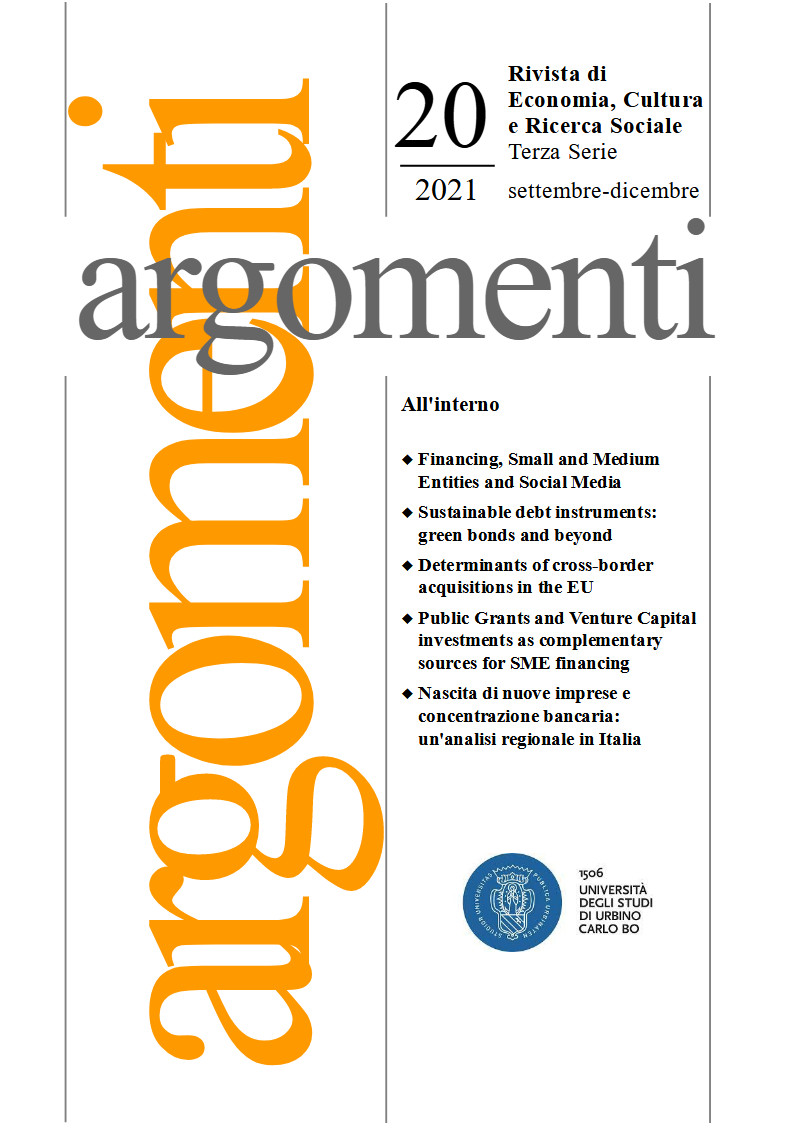Abstract
We analyze the different characteristics of companies, and in particular of Small and Medium Enterprises (SMEs), having access to forms of public subsidy or private financing. We then examine one of the most widespread public subsidies aimed at young and innovative SMEs of the European Union (i.e., Horizon 2020) and compare it with Venture Capital, a financial instrument typically oriented to fund equity of similar companies. Conversely, by comparing the characteristics of the companies that receive one or the other types of instruments, we find significant differences in the corporate characteristics of the funded companies both in terms of size (revenues, assets) and development phase.
References
Auerswald, P., & Branscomb, L. (2003). Valleys of Death and Darwinian Seas: Financing the Invention to Innovation Transition in the United States. [journal article]. The Journal of Technology Transfer, 28(3), 227-239. doi: 10.1023/a:1024980525678
Bellucci, A., Borisov, A., Gucciardi, G. and Zazzaro, A. (2021a), The reallocation effects of COVID-19: Evidence from venture capital investments around the world, Journal of Banking and Finance, forthcoming.
Bellucci, A., Gucciardi, G. and Nepelski, D. (2021b), Venture Capital in Europe. Evidence-based insights about Venture Capitalists and venture capital-backed firms, EUR 30480 EN, Publications Office of the European Union, Luxembourg, ISBN 978-92-76-26939-7, doi:10.2760/076298, JRC122885.
Cumming, D., Johan, S., & Zhang, Y. (2018). Public policy towards entrepreneurial finance: spillovers and the scale-up gap. Oxford Review of Economic Policy, 34(4), 652-675. doi: 10.1093/oxrep/gry012
Dvouletý, O., Srhoj, S., & Pantea, S. (2021). Public SME grants and firm performance in European Union: A systematic review of empirical evidence. Small Business Economics, 57(1), 243-263.
Gampfert, R., Mitchell, J., Stamenov, B., Zifciakova, J., & Jonkers, K. (2016). Improving access to finance: which schemes best support the emergence of high-growth innovative enterprises? A mapping, analysis and assessment of finance instruments in selected EU Member States JRC Scientific and Technical Research Reports. Publications Office of the European Union: Joint Research Center.
Gompers, P., & Lerner, J. (2001). The Venture Capital Revolution. Journal of Economic Perspectives, 15(2), 145-168. doi: 10.1257/jep.15.2.145
Gucciardi, G. (2019), Monitoring the development and integration of EU countries’ capital markets, JRC118408, Publications Office of the European Union, Luxembourg, doi:10.2760/92215.
Kaplan, S. N., Strömberg, P. and Sensoy, B. A. (2002), How well do venture capital databases reflect actual investments?, SSRN, 939073.
Kuckertz, A., Hinderer, S. and Röhm, P. (2019), Entrepreneurship and entrepreneurial opportunities in the food value chain, npj Science of Food, Vol. 3, No 1, pp. 1–5.
Nepelski, D., Piroli, G. and De Prato, G. (2016), European Start-up Hotspots: Analysis of venture capital financing in Europe, JRC101215, Publications Office of the European Union, Luxembourg.

This work is licensed under a Creative Commons Attribution 4.0 International License.
Copyright (c) 2022 Andrea Bellucci, Gianluca Gucciardi





